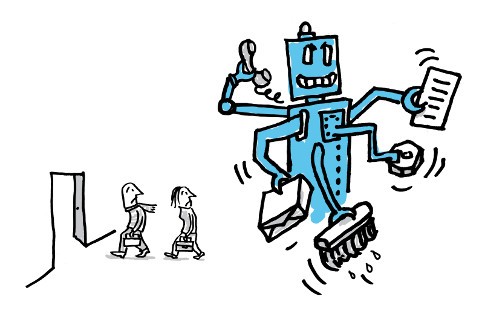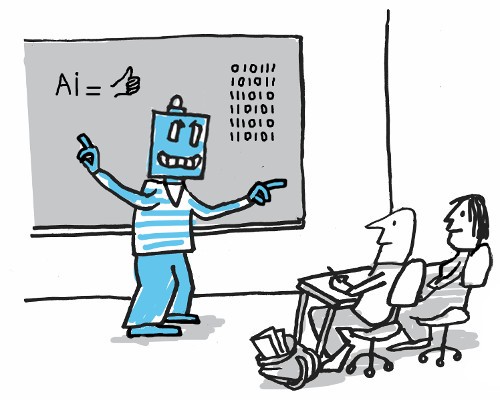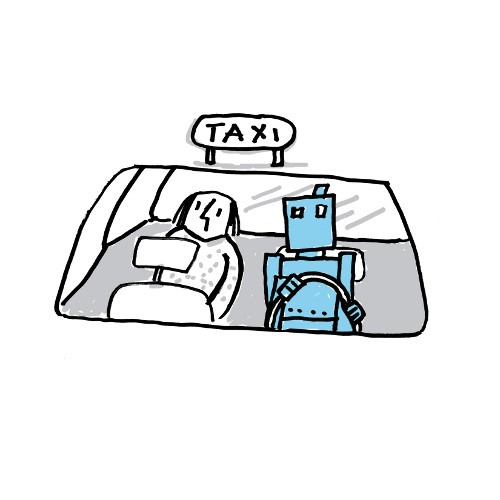17 august 2019
In the next 10 to 20 years, the capacities of robots will increase. What are the consequences of robotisation for existing and new occupations? Which jobs and occupations will be threatened by robots? What are the winners and losers of robotisation? And is robotisation good or bad for employment opportunities?

What are the winners and losers of robotisation? The University of Oxford researched this question. Whether an occupation is threatened by robotisation mainly depends on the tasks and activities associated with an occupation. Robots will be able to carry out an increasing number of tasks. Think of self-driving vehicles or devices that mow the lawn or drones that deliver a package. And there are also more robots that will take over tasks of highly educated people. For instance in the field of record keeping and auditing, which reduces the need for accountants and tax advisers. This is also evident from the top 10 occupations that run a high risk of disappearing as a result of robotisation, listed below.
Top 10 Occupations that Will Disappear as a Result of Robotisation
What type of occupations are particularly at risk? Mainly clerical staff, such as accounting assistants, secretaries and data entry clerks. But also assembly personnel, low-skilled workers in agriculture and fishing, machines and equipment operators, vehicle drivers, and shop personnel are at risk.
Which occupations are less sensitive to robotisation? View the top 10 of occupations that are not or barely sensitive to robotisation below. The percentage indicates the chances of this occupation disappearing in the coming 20 years as a result of the rise of robotisation and automation.
What immediately stands out is that this top 10 mainly consists of social and creative occupations. And they are particularly jobs in healthcare and education. Other occupations that are not in this top 10 but that will not soon disappear include supervising and coordinating occupations such as marketing manager, CEO and sales manager. However, a low chance of robotisation is not a good indicator for a high chance of employment. Many of the creative occupations will not soon be robotised, yet the job market perspective for photographers and make-up artists, for instance, is not very favourable.
Robotisation is viewed by many as a threat. Particularly to their likelihood of finding a job. However, robotisation also offers many positives. Lots of physical and often dangerous activities can be taken over by robots. But also boring and repetitive activities will be performed by machines and computers more often. Stuart Russell, Professor Computer Science at the University of Berkeley, specialising in artificial intelligence (AI), says, 'Throughout the centuries, people have been used as robots.' For instance when working farmland, in the mining industry, or in manufacturing. Often, these were very dangerous, strenuous, and monotonous activities. Activities that can now 'fortunately' be done by robots.
Robotisation also creates new occupations. John Markoff, Pulitzer Prize winning journalist, who has been writing about the impact of AI for 40 years, points out, 'As human beings, we're always very good at predicting what will disappear, but we're not good at predicting the new opportunities that will arise.' According to John Markoff, lots of new occupations will arise, occupations we hadn't even thought of. In the meantime, new occupations have already been created, such as motion designer, drone pilot, and big data specialist.
 In the field of employment, the World Economic Forum (WEF) states that, on balance, robotisation will create more jobs than it will make disappear. In their report, the WEF even shows that 58 million jobs, net, will be created through robotisation worldwide. Until 2022, approximately 75 million jobs could disappear, but 133 million jobs can also be created because of machines that take over certain activities. The WEF also indicates that particularly accountancy, industry, customer management, and clerical jobs run the greatest risk of being taken over by machines. On the other hand, the demand for occupations such as data analyst, software developer, and social mediaspecialist will increase. These are all jobs that arise from or are based on developments in the field of new technology and robotisation. In sectors where social skills are important, such as marketing or sales, the number of jobs will also continue to grow, according to the WEF-report. Finally, the WEF indicates that of the current employees, a little over half must gain new skills to be able to keep working. For lots of people, this means it will be important to get additional training or to retrain at some point.
In the field of employment, the World Economic Forum (WEF) states that, on balance, robotisation will create more jobs than it will make disappear. In their report, the WEF even shows that 58 million jobs, net, will be created through robotisation worldwide. Until 2022, approximately 75 million jobs could disappear, but 133 million jobs can also be created because of machines that take over certain activities. The WEF also indicates that particularly accountancy, industry, customer management, and clerical jobs run the greatest risk of being taken over by machines. On the other hand, the demand for occupations such as data analyst, software developer, and social mediaspecialist will increase. These are all jobs that arise from or are based on developments in the field of new technology and robotisation. In sectors where social skills are important, such as marketing or sales, the number of jobs will also continue to grow, according to the WEF-report. Finally, the WEF indicates that of the current employees, a little over half must gain new skills to be able to keep working. For lots of people, this means it will be important to get additional training or to retrain at some point.
The rise of robots and the developments in the field of artificial intelligence will change the labour market enormously. Paul Daugherty of management consulting agency Accenture warns companies not to wait and think that they will be able to find new people who have the right skills for the new job requirements. The required competencies of occupations change so quickly that companies must convert their own work force. Companies must do more to ensure their employees learn constantly. In the medical world, this is already happening. Nowadays, many surgeons and other medical specialists are looking more at computer screens than at the patient during medical procedures. Would you ask a gamer to perform the surgery? No, you need to make sure the doctor has the skills to do the surgery with a joystick. This is also becoming increasingly true for other occupations. In general, you could say that purely physical jobs will gain more digital elements. Therefore, it is important the business world starts to invest in training its employees. Otherwise, they run the risk of not being able to find personnel for the work that must be done in a robotised society.

The robotisation percentages of occupations mostly show which occupations are more sensitive to robotisation and AI. The higher the percentage, the higher the chance that much or a substantial part of the activities will be taken over by machines. That is certainly relevant when choosing an education or job or making a career change. Because a training programme or career choice is an investment in yourself where you, just like other investments, also look at the risks. Via the free career test, you can see which occupations suit you. And for each occupation, you can see what the chances of robotisation are, according to the University of Oxford. Is your profession at risk? Then ask yourself which activities in particular could be automated. Through training and courses, you can make sure you keep up. This could ensure that you can keep your position or that you can make a future-proof career change.